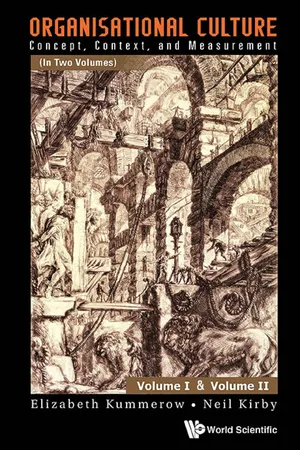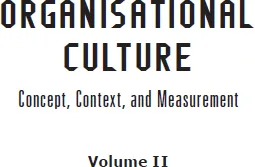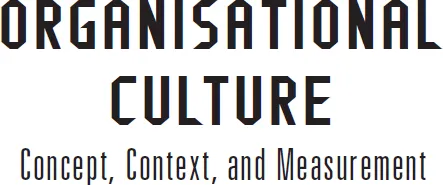![]()
![]()
![]()
![]()
Volume II
Elizabeth Kummerow
The University of Adelaide, Australia
Neil Kirby
The University of Adelaide, Australia
![]()
Published by
World Scientific Publishing Co. Pte. Ltd.
5 Toh Tuck Link, Singapore 596224
USA office: 27 Warren Street, Suite 401-402, Hackensack, NJ 07601
UK office: 57 Shelton Street, Covent Garden, London WC2H 9HE
The image on the cover is taken from WikiPaintings,
http://uploads8.wikipaintings.org/images/giovanni-battista-piranesi/the-lion-bas-reliefs.webp,
Public Domain, Artwork by Giovanni Battista Piranesi.
Library of Congress Cataloging-in-Publication Data
Kummerow, Elizabeth.
Organisational culture : concept, context, and measurement / Elizabeth Kummerow, Neil Kirby.
volumes cm
Includes bibliographical references and index.
ISBN 978-9814449519 (hardcover, v. 1 : alk. paper) -- ISBN 978-9814449526 (hardcover, v. 2 : alk. paper) -- ISBN 978-981-283-782-0 (hardcover : alk. paper)
1. Corporate culture. 2. Organizational behavior. I. Title.
HD58.7.K857 2014
302.3'5--dc23
2013027369
British Library Cataloguing-in-Publication Data
A catalogue record for this book is available from the British Library.
Copyright © 2014 by World Scientific Publishing Co. Pte. Ltd.
All rights reserved. This book, or parts thereof, may not be reproduced in any form or by any means, electronic or mechanical, including photocopying, recording or any information storage and retrieval system now known or to be invented, without written permission from the Publisher.
For photocopying of material in this volume, please pay a copying fee through the Copyright Clearance Center, Inc., 222 Rosewood Drive, Danvers, MA 01923, USA. In this case permission to photocopy is not required from the publisher.
In-house Editor: Lee Xin Ying
Typeset by Stallion Press
Printed in Singapore
![]()
Contents — Volume II
Contents — Volume I
Preface
About the Authors
PART FOUR: EXPLORING METHOD
Chapter 8An Exploratory Study of Organisational Culture (Study 1)
8.1Research Rationale and Introduction to Study
8.2The Research Setting: Background Information and Access
8.3Method
8.4Data Analysis and Results
8.4.1Themes pertaining to the nature of human nature
8.4.1.1Promotional practices
8.4.1.2Reward and recognition
8.4.1.3Performance appraisal
8.4.1.4Superior/Subordinate perceptions
8.4.2Themes pertaining to the nature of human relationships
8.4.3Themes pertaining to humanity’s relationship to nature
8.5Methodological Implications of the Findings of Study 1
8.6Conclusions
Chapter 9Piloting a Prototype Method (Study 2)
9.1Introduction to Study 2
9.2Research Method
9.2.1The interview protocol
9.2.2Participants in Study 2
9.2.3Procedure
9.3Approach to Data Analysis
9.4Results and Discussion
9.4.1Open-ended question
9.4.2Theory X — Theory Y rating
9.4.3Evaluation questions
9.4.4Personal experience questions
9.4.5Context questions
9.5Overall Evaluation of the Study 2 Method
9.6Conclusions
Appendix A
Study 2 Interview Protocol
Part A: The Role of Workers
Part B: The Role of Supervisors
PART FIVE: ANALYSING CONTEXT
Chapter 10 Towards a Refinement of the Method (Study 3, Part 1)
10.1Introduction to Study 3
10.2Key Design Features of the Revised Method
10.2.1Issue-focussed interview
10.2.2Semi-structured interview
10.2.3The operationalisation of context
10.2.3.1Context in the revised method
10.2.3.2Context in existing conceptualisations of organisational culture
10.2.3.3Context in existing approaches to the measurement of organisational culture
10.2.3.4A concluding comment on context
10.2.4The use of causal attributions
10.3Research Method
10.3.1The interview protocol
10.3.2Participants in the study
10.3.3Procedure
10.4Approach to Data Analysis
10.5Format for Reporting Results
10.6Conclusions
Appendix B
Study 3 Interview Protocol: The Role of Workers
Part A: Duties/Activities
Part B: Characteristics of Good Workers
Chapter 11 The Use of Semi-Structured Interviewing (Study 3, Part 2)
11.1Combining Open-Ended Questions with Closed Questions or Prompts
11.1.1Findings for the present context
11.1.1.1Open question data
11.1.1.2Prompt data
11.1.2Interpreting the discrepancy between open question and prompt data
11.1.2.1Findings for ‘information meetings’
11.1.2.2Findings for ‘attend training’
11.2The Use of Qualitative Data to Give Meaning to Quantitative Data
11.2.1Findings for ‘information meetings’
11.2.1.1What are information meetings?
11.2.1.2Thematic content analysis: Themes common to both divisions
11.2.1.3Thematic content analysis: Themes unique to each division
11.2.1.4Attributions data
11.2.1.5Concluding comments about the analysis of qualitative data on information meetings
11.2.2Findings for ‘attend training’
11.2.2.1What is training?
11.2.2.2Initial comments about worker involvement in training
11.2.2.3Thematic content analysis: Themes common to both divisions
11.2.2.4Thematic content analysis: Themes unique to each division
11.2.2.5Attributions data
11.2.2.6Concluding comments about the analysis of qualitative data on ‘attend training’
11.2.3Methodological issues arising from the analysis of qualitative data
11.3Conclusions
Chapter 12 The Operationalisation of Context (Study 3, Part 3)
12.1Organisational Culture as Context-Specific
12.2Spontaneous References to Contextual Domains in Responses to Questions About the Present
12.2.1References to the past in responses to questions about the present
12.2.2References to the future, other, and ideal in responses to questions about the present
12.2.3Methodological implications
12.3An Introduction to Contextual Data Elicited Through Specific Questioning
12.3.1Guide to reading Tables 12.3 and 12.4
12.3.2General observations about the nature of the responses to questions about context
12.4The Past Context
12.4.1Findings for the open questions
12.4.2Prompt questions: Some initial findings
12.4.3The past context: Summary of key findings
12.4.4An historical overview of the role of workers in each division
12.5The Future Context
12.5.1Findings for the open questions
12.5.2The difference between open questions and prompted responses
12.5.3Prompt questions: Some initial findings
12.5.4The future context: Summary of key findings
12.5.5Methodological issues arising from the findings for the future context
12.6The Other Context
12.6.1Results of the analysis of other context data
12.6.2The other context: Summary of key findings in terms of key divisional differences
12.6.3The other context: Methodological issues
12.7The Ideal Context
12.7.1Findings for the open questions
12.7.2Differences between the open and prompt questions
12.7.3The prompt questions: Some initial findings
12.7.4The ideal context: Summary of main findings
12.7.5Information about the ideal context: What does it add?
12.7.6Methodological issues arising from the findings for the ideal context
12.8Conclusions
PART SIX: EVALUATION AND FURTHER RESEARCH
Chapter 13 A Contextual Analysis of Organisational Culture: Evaluation and Recommendations for Future Research
13.1Evaluation of the Method: Key Features
13.1.1Issue-focussed interview
13.1.1.1Arguments in favour of an issue-focussed interview
13.1.1.2The ‘role of workers’: An evaluation of the issue chosen
13.1.1.3The ‘role of workers’: An evaluation of the questions asked
13.1.2Semi-structured interview
13.1.2.1Open-ended and closed questions: Benefits of their combined use
13.1.2.2Open-ended and closed questions: Do prompts introduce a social desirability bias?
13.1.2.3Open-ended and closed questions: Additional issues related to the use of prompts
13.1.2.4Open-ended and closed questions: The use of additional follow-up questions
13.1.2.5Elaborations and qualifications: Maximising the success of qualitative interviewing
13.1.2.6Elaborations and qualifications: Key benefits
13.1.2.7Elaborations and qualifications: The importance of a systematic approach to qualitative data analysis
13.1.3The operationalisation of context
13.1.3.1The past context: Advantages
13.1.3.2The past context: Specific versus general information about the past
13.1.3.3The future context: Advantages
13.1.3.4The future context: Organisational culture as an influence on, and influenced by, future expectations
13.1.3.5The other context: Advantages
13.1.3.6The ideal context: Advantages
13.1.3.7Integrating cultural contexts
13.1.4Respondents’ attributions and organisational (group) culture
13.2Evaluation of the Method: Comparison with Extant Approaches and Practical Considerations
13.2.1Comparison with extant approaches
13.2.1.1Advantages when compared with quantitative methods
13.2.1.2Advantages when compared with qualitative methods
13.2.2The proposed method: A tool for use in culture change?
13.2.3Practical considerations in using the proposed method
13.2.3.1Sampling and sample size
13.2.3.2Researcher involvement in the research setting
13.2.3.3Personality and skill requirements of the researcher
13.3Suggestions for Future Research
13.3.1Research using the existing data set
13.3.2Research involving additional data collection with our proposed method
13.3.3Research involving data collection with other measures, alone or in combination with our proposed method
13.4Conclusions
Chapter 14 Developing Attributions Analysis for Assessing Organisational Culture
14.1Overview of Approaches to the Assessment of Organisational Culture
14.2The Case for an Attributions Analysis Approach
14.3Introduction to the Present Analysis
14.3.1Research participants
14.3.2Data for the analysis
14.4The Coding Framework
14.5Results
14.5.1Codability of the data
14.5.2Coding reliability
14.5.3Findings for individual dimensions
14.5.4The content, and commonality, of specific causal factors
14.5.4.1Differences in causes between the divisions
14.5.4.2Similarities in causes between the divisions
14.5.4.3Summary of findings concerning the content of causal factors
14.5.5Interrelations among dimensions
14.6Summary and Methodological Implications
14.7Conclusions
References — Volume II
Author Index — Volume II
Subject Index — Volume II
![]()
Contents — Volume I
PART ONE: THE CONCEPT
Chapter 1 Organisational Culture: Development and Early Application
Chapter 2 Conceptualising Organisational Culture
Chapter 3 Describing Organisational Culture: Structure, Strength, and Differentiation
PART TWO: RELATED CONCEPTS
Chapter 4 Organisational Climate and National Culture
Chapter 5 Social Representations
PART THREE: MEASUREMENT AND CONTEXT
Chapter 6 Deciphering Organisational Culture
Chapter 7 Introduction to a Contextual Framework
References — Volume I
Author Index — Volume I
Subject Index — Volume I
![]()
Preface
What is this Book About?
This book is concerned with the concept and measurement of organisational culture. The first volume deals with the historical development of the organisational culture perspective and with existing approaches to the conceptualisation and measurement of organisational culture. It also considers a number of concepts that are closely related to organisational culture, namely, organisational climate, national culture and social representations. The concept of social representations is perhaps a surprising inclusion here, but as we will show, it has striking similarities to the concept of organisational culture, despite developing quite separately from it, within social psychology rather than in organisational psychology and management. The second volume of the book is predominantly methodological. It deals with the empirical investigation of a proposed method for assessing those aspects of an organisation’s culture that exist at a deeper level and that have proven to be particularly difficult to reveal. It has been recognised by researchers such as Steven Ott that problems associated with the measurement of organisational culture have prevented the concept from fully realising its useful application in practice, and have made it difficult for the organisational culture perspective more generally to achieve maturity.
An issue that is central to our treatment of organisational culture throughout this book, and that we believe sets the concept apart from other closely related concepts like organisational climate, is the idea that organisational culture exists at different levels. As Edgar Schein has so clearly articulated, an organisation’s culture can be thought of as comprising: a surface level associated with artefactual elements (the physical design of the organisation, its dress code, logo, etc.) and normative behaviours; a somewhat deeper and less easily discerned level of values that influence the culture’s more observable manifestations; and, at its core, an even deeper level of beliefs and assumptions that over time may have become taken-for-granted and unconscious, but that nevertheless profoundly affect how the organisation operates and, in particular, how it responds to challenges and change. While practically useful quantitative measures of normative behaviours and values have been developed to assess the more surface levels of organisational culture, accessing the deeper level of unconscious beliefs and assumptions has proved to be much more difficult. Culture at this deeper level has traditionally been investigated using qualitative methods, akin to those used in anthropology, which require considerable time and lived experience in an organisation, and which are therefore compromised in terms of their practical usefulness, for example, for understanding and facilitating change in organisations. It is the central purpose of this book to propose and investigate a method that, when compared with existing approaches, might provide a more systematic and more economical means whereby to decipher organisational culture at the level of basic beliefs and assumptions. To the extent that such a method could be developed, it would allow this most basic and influential aspect of the concept to achieve a level of theoretical and practical utility that, in our opinion, it has not yet achieved.
To Whom is this Book Addressed?
This book has been written with two audiences in mind. The first volume has been designed primarily for teaching and study purposes, for use in postgraduate level courses in which an understanding of the concept of organisational culture and its measurement is required. We have assumed that such courses will most likely be concerned not only with the theory of organisational culture but also with the practical usefulness of the concept for understanding organisations and how they operate, particularly in response to challenges and change. In the context of addressing these issues, in the first volume we also review the research on the related concepts of organisational climate, national culture, and social representations. A key objective in this regard is to consider how the integration of these concepts with the concept of organisational culture might contribute to a more comprehensive account of the social and cultural aspects of organisations.
The content of this book has been shaped in important ways by the scholarship of others working in the area of organisational culture. A major (and perhaps the foremost) influence has been the work of Edgar Schein. Schein’s conceptual treatment of organisational culture — in particular, the distinction that he draws between a culture’s surface-level elements and the deeper-level elements that constitute its ‘essence’ — remains, in our opinion, the most useful and well articulated of its kind. It successfully conveys the complexity of the phenomenon, at the same time as making sense of it in a way that is at once intuitively appealing, theoretically important, and practically useful.
We agree with Schein that one of the key benefits of a cultural analysis of an organisation that is based on a depiction of culture as multi-layered is that it can reveal discrepancies between the elements comprising the different levels of the organisation’s culture, and these discrepancies can help to explain complex and sometimes counterproductive aspects of how the organisation operates. The value of an understanding of this kind is perhaps most apparent when seeking to explain why it can be so difficult to achieve change in organisations. The research suggests that the implementation of a proposed change can encounter serious difficulties (and perhaps fail) even when there seems to be broad agreement among the organisation’s member...




